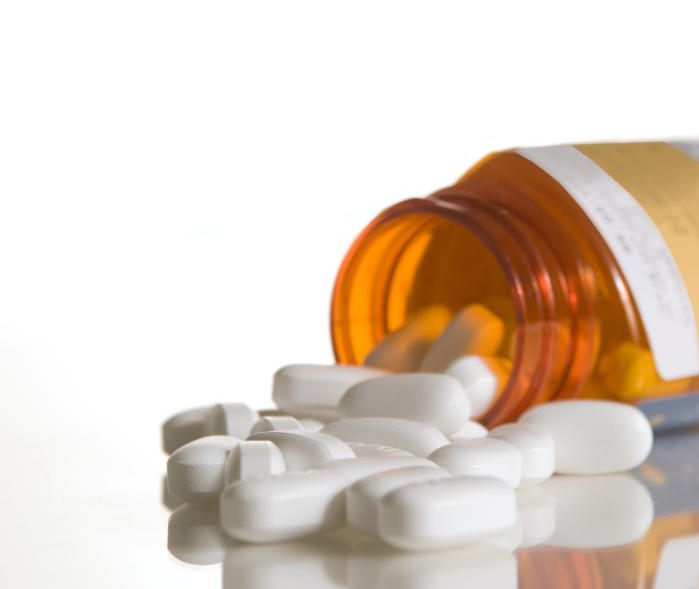Once impulse arrives, calcium moves in, resulting in excitation-secretion coupling. To save dopamine, it is taken up by storage vesicles because monoamine oxidase metabolizes any neurotransmitter present.
Drugs may:
- Interfere with synthesis of noradrenaline (Methyrosine)
- Interfere with storage of dopamine (Reserpine)
- Interfere with release of noradrenaline (Guanethidine)
Drugs which prevent release of noradrenaline
- Guanethidine
- Guanadrel
- Bethanidine
- Debrisoquine
- Bretylium
Drugs that inhibit storage of noradrenaline
Drugs that interfere with synthesis of noradrenaline:
Metyrosine
Guanethidine
Source and structure
Synthetic drug, polar, thus it is difficult for it to cross the blood brain barrier. Has peripheral action, and not central. Half life is 5 days.
Mechanism of action
1. Reuptake 1 or uptake 1
This is necessary for the action to occur. After it is reuptaken, it blocks the release of noradrenaline.
2. Membrane stabilizing effect (MSA)
Guanethidine has local anaesthetic effect. It decreases the movement of ions across membrane, thus decreasing the action potential and NE release. It decreases the excitation-secretion coupling.
3. Displacement of noradrenaline
4. Substitute neurotransmitter
Once guanethidine displaces noradrenaline, it is located in the storage vesicles. Every time action potential arrives; guanethidine is released, which is devoid of activity on alpha and beta receptors. Thus acts as a false neurotransmitter.
5. Blocks sympathetic system
Pharmacokinetics
Very high volume of distribution, as drug is present within storage vesicles. Oral bioavailability is low i.e. 5-50%. Steady state concentration is achieved after 20 days. Any dose cannot be adjusted before this time. Sympathoplegia persists even after cessation of therapy for some time.
When taken orally, only fall in blood pressure occurs.
Half life is about 5 days.
Pharmacological effects
CVS
Causes decrease in blood pressure and decreased TPR as well as cardiac output. Sympathoplegia results in bradycardia, dilatation of capacitance venules occurs, thus pooling of blood takes place decreasing the venous return. This causes decreased cardiac output. TPR also decreases sympathoplegia.
Actions depend on the route of administration and how rapidly given:
1. If rapidly given I/V triphasic response of blood pressure is observed. Initial fall is followed by rise, which is followed by gradual fall:
Initial fall is due to the ability of drug to block noradrenaline. Once taken up, more drug reaches the cytoplasm and displaces noradrenaline. Overwhelming quantity of noradrenaline is displaced, some of which spills out of the nerve terminal and reaches the systemic circulation. This is responsible for the rise. After some time all neurotransmitter is displaced, and guanethidine behaves as a false neurotransmitter, then a decline is observed.
2. If given slowly I/V, only biphasic response is seen. There is no initial fall.
The drug is taken up by the storage vesicles, noradrenaline is released, thus rise is observed on slow I/V injection, once false neurotransmitter acts, fall is seen.
3. If drug is given orally, levels rise slowly, only monophasic response occurs.
Local anaesthetic activity occurs, and as substitute offsets the release of noradrenaline, MAO takes care of the noradrenaline released.
Increased sympathetic activity is associated with increased guanethidine activity.
Renal
Initially slightly decrease in blood flow occurs because of auto regulation. Later salt and water retention causes increase in plasma volume and increased blood pressure, thus pseudo tolerance is seen. Diuretics may be given as remedy.
GIT
Blocks sympathetic activity, increasing the parasympathetic activity, which leads to increased motility of gut. This might result in abdominal cramps, diarrhoea.
Eye
Dilator pupillae are blocked, parasympathetic sphincter has unopposed action causing miosis. Decrease in intraocular pressure is also observed.
CNS
Drug does not cross BBB, so has no effect.
Therapeutic uses
Hypertension
This was mainly used quite some time back, now its usage is obsolete. Better options are available having less toxicity. Also this drug blocks sympathetic system, thus super sensitivity occurs at catecholamine receptors.
Adverse effects
1. Postural Hypotension (under control baroreceptors, increased sympathetic discharge blocked so only acting peripherally)
2. Weakness
3. Worsening of CCF (heart is not pumping enough, no Frank Starlings’ law and no increase in sympathetic activity.)
4. Fluid Retention(long term control HTN by kidneys. When blood pressure is decreased:
a. Redistribution of intra-renal blood flow occurs, independent of renin secretion, leading to salt and water retention.
b. Because of rennin secretion, stimulation of rennin-angiotensin-aldosterone axis occurs, leading to salt and water retention.
Antihypertensive effects are blunted by this fluid retention and tolerance develops. Thus these drugs work best when combined with diuretic.
5. Diarrhoea (over activity of parasympathetic system)
6. Delayed Ejaculation (retrograde ejaculation as sympathetic system is blocked)
7. Nasal Congestion (depending upon blood flow, increase in no. and decrease in size. Also increased blood flow because of sympathoplegia, there is increased size of turbinates in lateral wall leading to nasal congestion)
Drug Interactions
If drug is not reuptaken, no effect is produced. TAD, cocaine and Phenylpropanolamine (nasal decongestant) completely block the actions. Thus they cannot be given together.
Guanethidine may cause super sensitivity of receptors, leading to up regulation of alpha 1 receptors causing intense vasoconstriction (HTN crisis).
|
Guanethidine |
|
| Source-Synthetic | Natural |
| M.A.O- Reuptake 1 | Blockage Mg++ ATP pump |
| Pharmacological Actions- tiphasic, biphasic, monophasic response | Gradual fall in blood pressure |
| Postural hypotension | No or mild postural hypotension |
| Therapeutic Uses | |
| Non-antipsychotic | Anti-psychotic |
| No suicidal tendencies | Suicidal tendencies |
Continue Reading
Browse all articles on Autonomic Nervous System
 howMed Know Yourself
howMed Know Yourself




